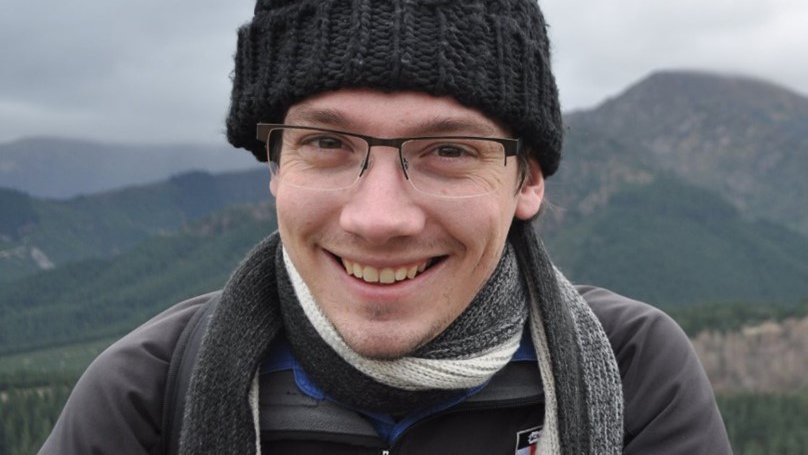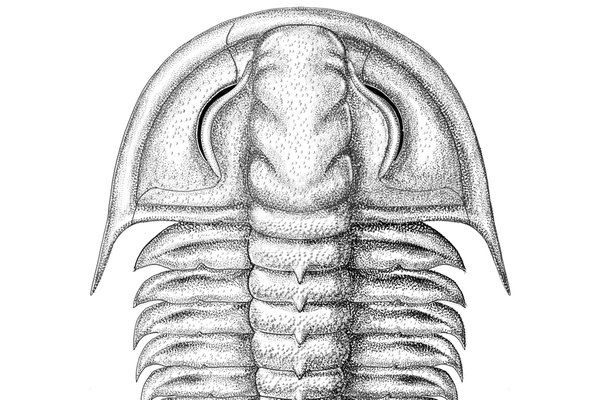Newly discovered fossil species named after Doctor Who
A newly discovered trilobite species has been named after Doctor Who actor Tom Baker, by Australian Museum and University of New South Wales scientists, honouring his legacy of encouraging young people into careers in STEM.
A previously undescribed trilobite, Gravicalymene bakeri, has recently been discovered within the palaeontology collection at the Australian Museum. The new species was originally found in far northern Tasmania, from rocks of the Late Ordovician Period (approximately 450 million years ago). It represents the earliest record of this genus from East Gondwana – what is now Australia, Antarctica, New Zealand, southern China and south-east Asia. It is also one of only two species in the subfamily Calymeninae, in Australia.

Gravicalymene bakeri sp. nov., A near complete paratype specimens (left) and a life reconstruction of the animal (right).
Image: Dr Patrick Smith© Australian Museum
Traveling back to the start of 2018, I was working at the University of New South Wales (UNSW) in the Department of Biological, Earth and Environmental Science. One of my duties was supporting a student field trip examining fossil sites around the Wellington Caves, New South Wales. Dr Malte Ebach, one of the lecturers in the department, also joined the trip since his PhD had previously discussed fossils of a similar age.
During the five-hour bus drive to the Wellington Caves, Malte and I started discussing our mutual interest in the science-fiction TV series “Doctor Who.” The show essentially revolves around an alien that can travel through both time and space, using his intelligence and science to defeat evil in the cosmos (rather than a gun or brute force). Despite the nearly 15-year difference between us, Malte and I found that the series had encouraged us to start careers in science. In particular, one of the longest serving actors to play the role – Thomas (Tom) Stewart Baker – was one of our mutual role models.

Map of Tasmania highlighting the location of rocks belong to the Gordon Group and Gunns Plains region.
Image: Dr Patrick Smith© Australian Museum
Fast-forward a year, and I was visiting UNSW to present a lecture. Whilst there, I had a chat with Malte about trilobites and Doctor Who. During the conversation, Malte mentioned that he had been part of a trip to northern Tasmania in 1997 which had collected trilobites that were now stored at the Australian Museum. However, he was unsure if any of the material had ever been examined by a trilobite expert (sometimes known as a “trilobitologist”), such as myself.
The very next day, I looked through the vast collections of fossils at the Australia Museum and came across a drawer labelled “Trilobite, Ordovician, Tasmania.” Surely enough, Malte’s specimens were in the drawer, and even more excitingly, they appeared to be a new species of Gravicalymene. The convention for naming new species (termed the International Code of Zoological Nomenclature, see more from our AM blog here) requires that that all new names must have a unique ‘genus species’ combination (called a binomial name). This is particularly difficult for species of Gravicalymene, as there are currently over thirty species in the genus – with names such as Gravicalymene australis, Gravicalymene cootamundrensis and Gravicalymene hornyi, to name a few.
Malte and I discussed what we should name this new species. We considered names of places and people that have influenced our lives. However, both of us agreed that it would be best to name it after our shared childhood role model. We thought this would be an excellent way of acknowledging his enduring legacy in promoting science. Tom Baker was so delighted by this honour that when told, he sent an email saying: “I am delighted to be entitled at last…..I hope the ‘Who’ WORLD will celebrate this fresh honour and will spread the news to those who live in remote places. Happy Days to all the ‘Who’ fans everywhere.”
This just goes to show the influence that scientifically minded role models have on children. Through their actions, children may find careers which will lead them into STEM based fields. At a time when we desperately need more scientists and engineers (with threats such as pandemics and global climate change being ever present), we need to ask ourselves “what can we do to prompt children to study the world around them?”

Fourth Doctor Portrait, Tom Baker as Dr Who.
Image: JoRockleyArt© Pixabay.com
Dr Patrick Mark Smith, Technical Officer, Palaeontology, Australian Museum Research Institute.
More information
- Smith & Ebach (2020). A new Ordovician (Katian) calymenid, Gravicalymene bakeri sp. nov., from the Gordon Group, Tasmania, Australia. Wales, Alcheringa. An Australasian Journal of Palaeontology. DOI: 10.1080/03115518.2020.1797874.
- TARDIS sets scientists on course to discover 450-million-year-old fossil. Sydney Morning Herald. https://www.smh.com.au/national/nsw/tardis-sets-scientists-on-course-to-discover-450-million-year-old-fossil-20200915-p55vxt.html.
- Extremely rare fossils of ancient sea life found in Tasmania, 2020.















